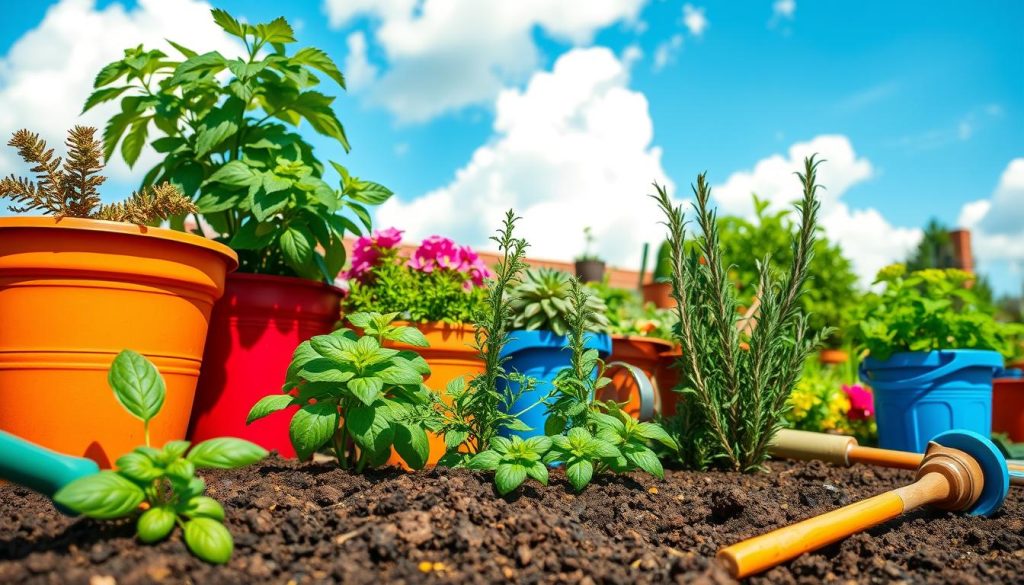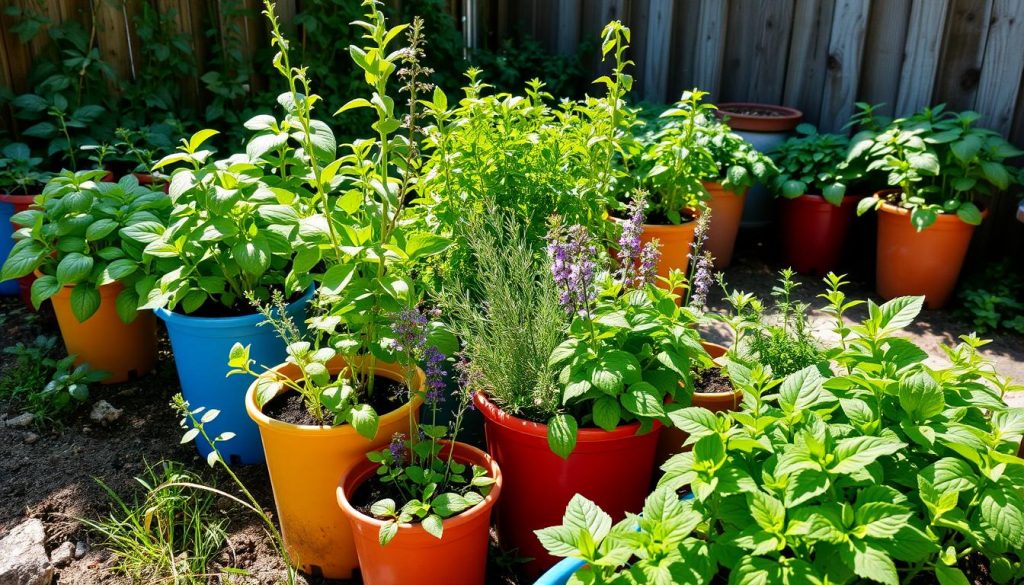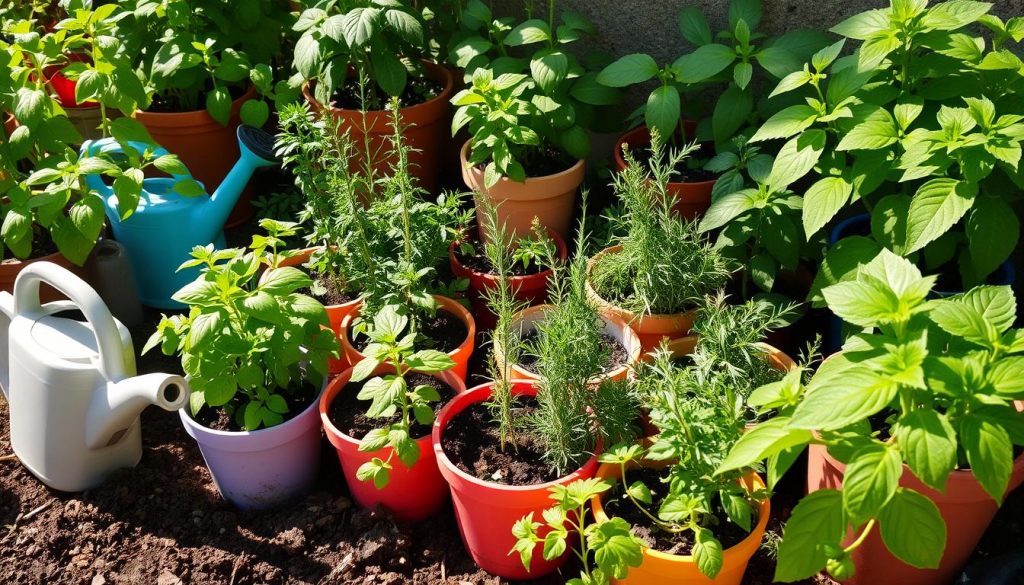Herb gardening is a fun and rewarding hobby. It gives you fresh, tasty herbs for cooking and more. This guide will help you learn how to plant and care for herbs. You can grow them in gardens or in pots indoors, making it easy for everyone to start.

Key Takeaways
- Herbs offer a high return on investment with minimal time and effort.
- Herbs can be grown indoors and outdoors, making them suitable for gardeners of all skill levels.
- Proper soil preparation and understanding light requirements are crucial for successful herb cultivation.
- Herbs have diverse growth cycles, from annuals to perennials, requiring tailored planting and care schedules.
- Proper harvesting and storage techniques can extend the shelf life of fresh herbs.
Getting Started with Your Herb Garden
Starting an herb garden is exciting. It brings fresh flavors to your cooking and creates a fragrant space. You’ll need tools, know about light, and find the right spot for your herbs to grow well.
Essential Tools and Materials
You’ll need containers, good potting soil, and herbs to start. Gardening tools like trowels and watering cans are also helpful. These basics will kick off your herb gardening journey.
Understanding Light Requirements
Most herbs need lots of sunlight, 6-8 hours a day. Choose a sunny spot for your garden. For indoor gardens, a south-facing window is best.
Selecting the Perfect Location
The location should be sunny and easy to reach. It should also protect from strong winds. Near the kitchen is great for easy access to fresh herbs. Outdoor spots should be sheltered from harsh weather.
With the right tools, light knowledge, and a good spot, your herb garden will thrive. It will be a joy and inspiration in your home. Enjoy your herb gardening journey!
Creating the Perfect Soil Mix for Herbs
Making the right soil mix is key for a thriving herb garden. The best mix has equal parts topsoil, compost, and coarse sand. This mix drains well and gives plants the nutrients they need for strong roots and healthy growth.
To make this mix, start with topsoil as the base. Add compost for nutrients and coarse sand for better drainage. Mix everything well to get a light, draining soil that’s perfect for herbs.
For even more nutrients, add earthworm castings on top. This natural fertilizer gives plants the nutrients they need all season. Make sure to mix everything well for a balanced soil texture.
- Topsoil: Provides the base for the soil mix
- Compost: Adds essential nutrients for plant growth
- Coarse Sand: Enhances drainage and aeration
- Earthworm Castings: Offers a natural nutrient boost
Creating this custom soil mix sets your herbs up for success. The mix’s good drainage and nutrients help your herbs grow well. This means a big harvest of fresh, tasty herbs.
Essential Indoor Growing Conditions
To grow a thriving herb garden indoors, you need to keep certain conditions right. Focus on temperature, humidity, and air flow. These are crucial for your herbs to grow well indoors.
Temperature Control
Most herbs do best in temperatures between 60-70°F (15-21°C). Don’t let your indoor herb garden get too hot or cold. A steady, moderate temperature is best for your herbs to grow well.
Humidity Management
Herbs like a bit of moisture in the air. Mist your plants often or use a pebble tray with water. This makes the air feel more like outside, helping your herbs grow strong and green.
Air Circulation Tips
Good air flow stops mold and pests in your indoor herb garden. Use fans to move the air gently around your plants. This keeps them healthy and helps them grow well.
Keep the right temperature, humidity, and air flow for a great indoor herb garden. These conditions will make your herbs thrive, even indoors.
Planting Herbs: Step-by-Step Guide
Growing herbs at home is rewarding. It can make your cooking better and add greenery to your space. Here’s how to start and make sure your herbs grow well.
- Prepare the soil mix: Start by making the best soil for your herbs. Use Miracle-Gro® Raised Bed Soil for beds or Miracle-Gro® Moisture Control® Potting Mix for pots.
- Sow the seeds: Plant seeds at the right depth for each herb. Most need about 1/4 to 1/2 inch deep.
- Water gently: Water the seeds lightly. Keep the soil moist until they grow.
- Thin seedlings: When seedlings grow, thin them out. This lets each plant have room to grow.
- Transplant indoor-grown seedlings: If you started herbs indoors, harden them off before moving them outside.
- Space plants properly: Think about how big each herb will get. Plant them far enough apart for growth.
- Water thoroughly: Water your herbs well after planting. This helps them get a strong start.
By using these herb planting techniques, you’ll have a great herb garden. It will give you lots of tasty herbs to use.
Popular Culinary Herbs and Their Care
Starting an herb garden at home is rewarding and flavorful. Basil, mint, and parsley are top choices, each needing different care. Knowing their needs helps gardeners grow a lot and enjoy their taste and smell in cooking.
Basil Cultivation
Basil loves warm, sunny spots. Start seeds indoors 6-8 weeks before the last frost. When outside, pinch off top leaves to keep it bushy and prevent it from growing too fast.
Mint Growing Tips
Mint grows fast and can spread a lot. Plant it in a container or a special area to stop it from taking over. Regularly picking leaves keeps it healthy and encourages new growth.
Parsley Care Guide
Parsley takes two years to grow fully. Soak seeds overnight to help them germinate faster, which can take 14 days. Move seedlings to bigger spots when they’re 6 inches tall for better growth.
With these tips, gardeners can have a fragrant herb patch. These herbs will grow well and add flavor to home-cooked meals.
Understanding Herb Growth Cycles
As avid herb gardeners, knowing the growth cycles of these plants is key. From annuals that grow and die in a year to perennials that come back every year, each needs special care.
Annual herbs like basil and cilantro grow fast. They reach full size in just one season. This makes them perfect for quick harvests and replanting.
Biennials, such as parsley, live for two years. The first year, they grow leaves. The second year, they flower and produce seeds. Gardeners must plan to enjoy these herbs fully.
Perennial herbs, like thyme and oregano, live a long time. They take a year to grow, then produce well for years. Taking care of them in winter helps them come back every year.

Knowing these growth cycles is vital for a successful herb garden. By matching planting and harvesting with each herb’s needs, gardeners can have a constant supply of fresh herbs all year.
Seasonal Planting Calendar
Keeping your herb garden alive all year needs careful planning. Knowing when to plant and how to care for your herbs is key. Let’s look at the seasonal planting calendar and learn how to keep your garden thriving.
Spring Planting Schedule
Spring is the time to start planting most herbs after the frost is gone. It’s a great chance to get your garden growing. For herbs like basil, start them indoors before moving them outside.
By planning your spring planting well, you’ll get the most out of your herbs.
Summer Maintenance
Summer means your herbs need regular care. Make sure they get enough water, but not too much. Picking your herbs often helps them grow more.
Try planting new seeds of annual herbs every few weeks. This keeps your garden full of fresh herbs all summer.
Fall and Winter Care
As the weather cools, your garden needs extra care. In fall, plant cold-hardy herbs. Also, protect your perennial herbs with mulch for winter.
If you have an indoor garden, keep the temperature and light steady. This helps your herbs grow well, even when it’s cold outside.
By using a seasonal planting calendar and adjusting your care, you can have a vibrant herb garden all year. Remember, your local climate might affect what works best, so adjust these tips as needed.
Container Gardening for Herbs
Container gardening is great for those with little space. You can grow many herbs in pots, right by your door or indoors. Make sure your pots have holes for water to drain and are at least 6-8 inches deep for the roots.
Put herbs that need the same amount of water and light together. Self-watering pots are perfect for herbs like chives and mint. But, herbs like oregano and thyme do better in drier conditions.
- Most herbs need full sun for 6-8 hours a day.
- Don’t over-fertilize, as herbs usually don’t need extra nutrients.
- Harvest your herbs often to encourage more growth and a bigger harvest.
Container gardening is a fun and space-saving way to grow herbs. With the right plants and care, your herb garden will thrive all season.
Water and Fertilization Requirements
Keeping the right balance of water and nutrients is key for a healthy herb garden. Most herbs like well-drained soil and moderate watering. It’s important to water when the top inch of soil feels dry to avoid root rot.
Herbs in containers might need more water, especially when it’s hot. Check the soil daily and water when it starts to dry out. This way, your herbs stay hydrated without getting too wet.
Watering Schedule
- Water herbs when the top inch of soil feels dry to the touch.
- Container-grown herbs may need daily watering during hot, dry conditions.
- Avoid letting the soil become completely dry, as this can stress the plants.
Natural Fertilizer Options
Use natural fertilizers like compost tea or diluted fish emulsion to feed your herbs. Apply these organic amendments monthly during the growing season. But be careful not to over-fertilize, as it can make your herbs taste less flavorful.
- Compost tea: A nutrient-rich liquid fertilizer made by steeping compost in water.
- Diluted fish emulsion: A water-soluble fertilizer derived from fish byproducts.
- Avoid over-fertilizing, as it can diminish the essential oils and flavor of your herbs.

Stick to a regular watering schedule and use natural fertilizers wisely. This will help your herb garden grow strong and healthy. You’ll enjoy a rich harvest of tasty, aromatic herbs all season long.
Propagation Techniques
Growing your own herbs at home is rewarding. Propagation techniques help you grow your herb garden easily. Whether you’re new or experienced, knowing how to propagate herbs is key to a thriving garden.
Seed sowing is a simple way to start herbs like basil and cilantro. Just follow the seed packet instructions for the best results. Make sure the soil and environment are right for germination and growth.
- Seed propagation is a cost-effective way to grow a wide variety of herbs from scratch.
- Pay attention to the recommended soil temperature range for each herb to ensure successful germination.
- Expect a germination rate of 65-80% for fresh herb seeds, with 60-75% of those seedlings developing into healthy, vigorous plants.
For perennial herbs like thyme and mint, stem cuttings work well. Cut a piece of the parent plant and root it in soil or water. This way, you get a new plant that’s just like the original.
- Choose tender, new growth with at least three nodes and a terminal bud for the best results.
- Dip the cutting in rooting hormone before planting to speed up the root development process.
- Expect the cutting to develop roots within four to six weeks, at which point it can be transplanted into its own container or the garden.
Division is another good method for perennial herbs like chives and oregano. This involves splitting the plant and replanting it. It’s best done in spring, giving the new plants time to grow strong.
Choose the right environment for your new plants. This includes the right light, temperature, and humidity. With a little care, your herb garden will grow and flourish for years.
Pest Management and Disease Control
Keeping your herb garden healthy means fighting pests and diseases. Aphids, spider mites, and whiteflies are common pests. Root rot and powdery mildew are diseases you might face. It’s important to act early to protect your herbs.
Combating Common Herb Pests
Aphids, spider mites, and whiteflies can harm your herbs quickly. To stop them, make sure your garden has good air flow and the right amount of water. Natural solutions like neem oil or insecticidal soap can also help control these pests.
Natural Prevention Methods
- Companion planting can help deter pests by introducing beneficial insects and plants that repel unwanted visitors.
- Promptly remove any affected plant parts to prevent the spread of diseases like root rot and powdery mildew.
- Maintain optimal growing conditions, such as proper temperature, humidity, and air flow, to discourage pest infestations and disease outbreaks.
By being watchful and using natural ways to prevent pests and diseases, your herb garden will flourish. Regular checks and early action will help you enjoy a rich harvest of fresh herbs.
Harvesting and Storage Methods
Enjoying your homegrown herbs’ vibrant flavors starts with the right harvesting and storage. Harvest herbs in the morning, after the dew has dried. Cut off up to one-third of the plant’s leaves, leaving enough for the plant to grow.
For annual herbs like basil and marjoram, just pinch off the leaves. Perennial herbs, such as thyme and sage, should be cut 3-4 inches from the base. Harvest flowering herbs like tarragon and lavender when buds start to form but before they open.
To preserve your herb gardening harvest, drying is a great method. Lay the herbs out in a single layer on a clean, dry surface. When they’re dry and crumbly, store them in airtight jars or containers. This keeps their culinary herbs flavor and potency for up to a year.